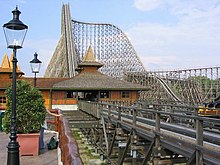
Back Dřevěná horská dráha Czech Holzachterbahn German Montaña rusa de madera Spanish Montagnes russes en bois French Houten achtbaan Dutch 木過山車 ZH-YUE
This article needs additional citations for verification. (August 2017) |





A wooden roller coaster is a type of roller coaster classified by its wooden track, which consists of running rails made of flat steel strips mounted on laminated wood. The support structure is also typically made of wood, but may also be made of steel lattice or truss, which has no bearing on a wooden coaster's classification. The type of wood often selected in the construction of wooden coasters worldwide is southern yellow pine, which grows abundantly in the southern United States, due to its density and adherence to different forms of pressure treatment.
Early wooden roller coaster design of the 19th century featured a single set of wheels running on top of the track, which was common in scenic railway rides. John A. Miller introduced side friction coasters and later underfriction coasters in the early 20th century, which added additional sets of wheels running along multiple sides of the track to allow for more intense ride design with sharper turns and steeper drops. The underfriction design became commonplace and continues to be used in modern roller coaster design.
Traditionally, wooden roller coasters were not capable of featuring extreme elements such as inversions, near-vertical drops, and overbanked turns commonly found on steel roller coasters after the introduction of tubular steel track by Arrow Development in 1959. Son of Beast at Kings Island made history in 2000 by incorporating the first successful attempt of an inversion on a wooden coaster, a vertical loop made of steel. A decade later, the introduction of Topper Track by Rocky Mountain Construction allowed for new possibilities, with corkscrews, overbanked turns, and other inverting elements appearing on wooden coasters such as Outlaw Run at Silver Dollar City and Goliath at Six Flags Great America.
- ^ Tieteen kuvalehti Historia 11/2014, p.74 (in Finnish)